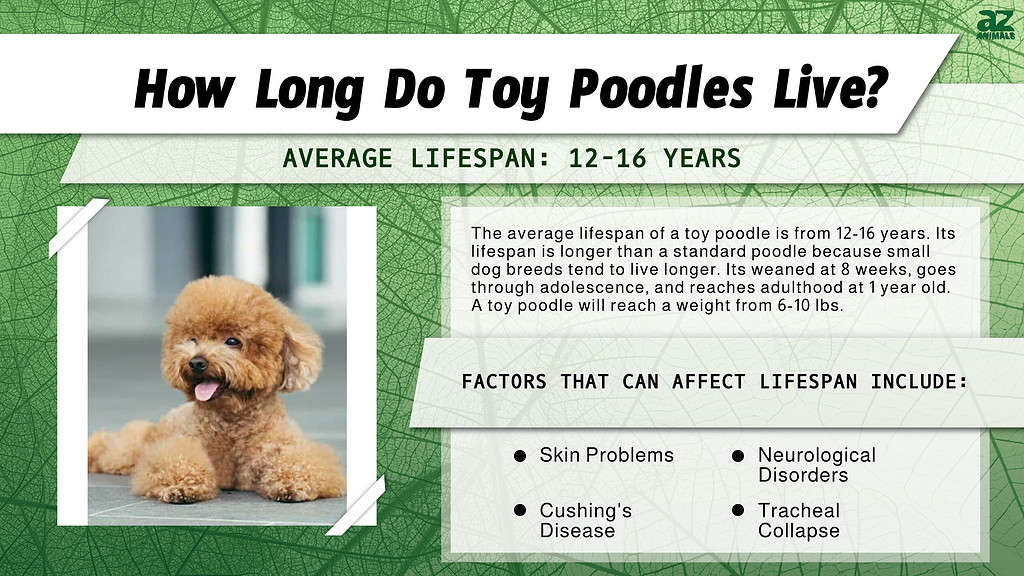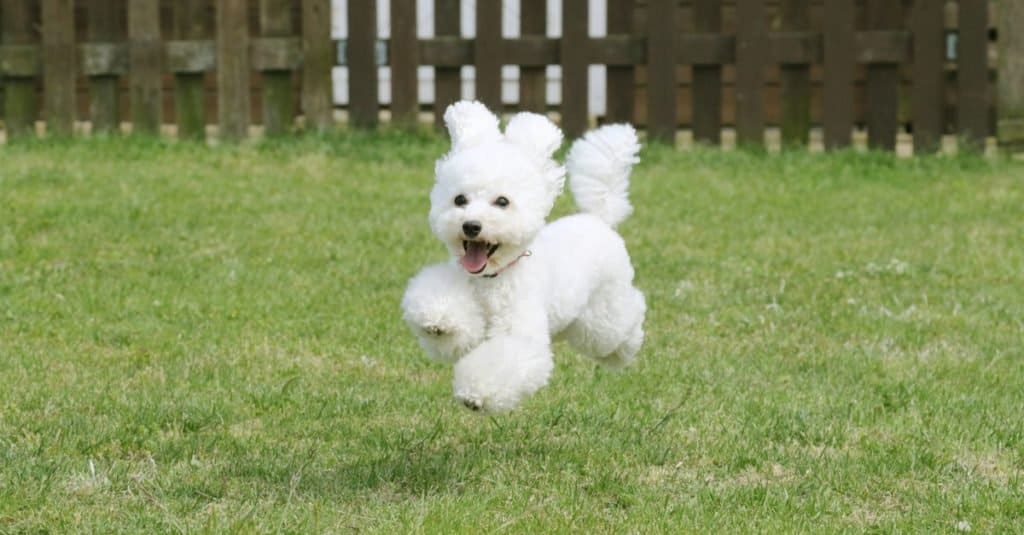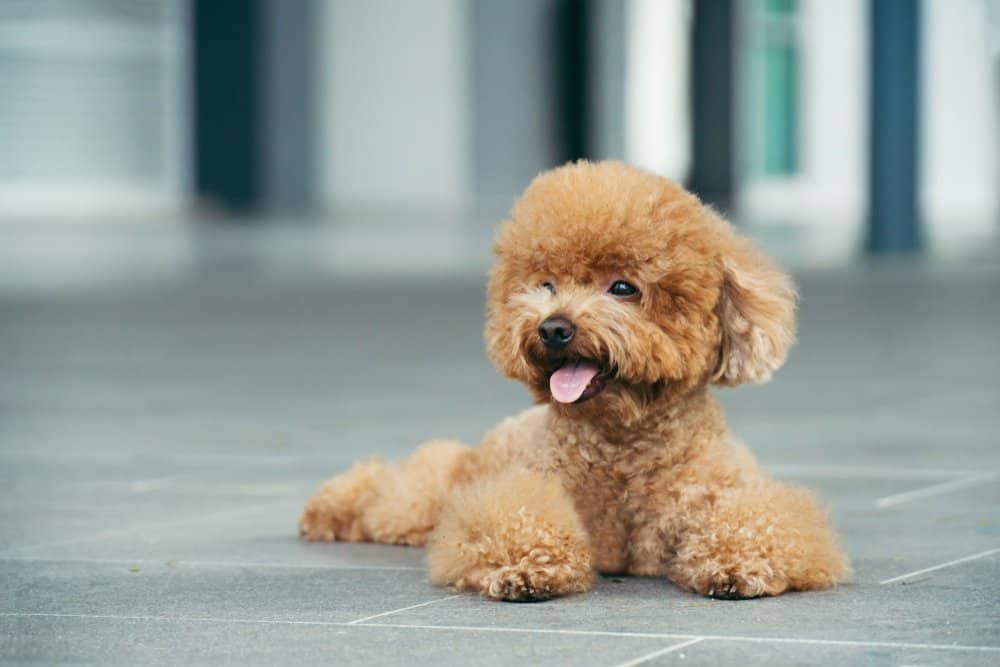The toy poodle, the smallest of the Poodle breeds, is a highly trainable, clever, athletic, and adaptable dog. The toy poodle was developed at the beginning of the twentieth century when breeders reduced the size of the miniature poodle to make another popular companion dog.
Because of their petite size, toy poodles may be content in small places without requiring excessive amounts of physical exercise. As a result, toy poodles are excellent companions for those of us that live in apartments and dog enthusiasts who do not want to commit to a high-energy breed.
Are you interested in owning your own toy poodle? Let’s go over some of the most important facts about this breed, including the average toy poodle lifespan.
How Long Do Toy Poodles Live?

The average toy poodle’s lifespan is between 12-16 years. This is comparable to other poodle breeds. The standard poodle has a general lifespan of around 12-15 years of age. The miniature poodle’s lifespan is around 15 years. The smaller poodle breeds can live a year or two longer than the standard. This is due to their smaller size.
Generally speaking, smaller dog breeds tend to outlive larger ones. According to the research comparing size and age-related mortality in dogs, it was revealed that larger canines die younger because they age much faster than smaller ones. Some studies suggest that a larger dog’s physiological systems are put under more strain due to its size, causing them to wear down faster.
Typically, the average lifetime for relatively large dogs is around seven years, and 14 years for smaller dogs. Now that we know how long toy poodles live, let’s look at how they grow from puppy to adult!

Compared to other dog breeds, toy poodles have a relatively long lifespan of around 12-16 years.
©studio hoto/Shutterstock.com
The Average Toy Poodle Life Cycle
Poodles are one of the most popular dog breeds, and toy poodles are no exception to that! Let’s learn all about how toy poodles go through their developmental stages.
Puppies

Toy Poodles should be weaned when they are 8 weeks.
©Eloine Chapman/Shutterstock.com
Toy poodle puppies are born blind and deaf until they are about two weeks old. Puppies are fully reliant on their mothers for everything at this time, including body temperature control. Toy Poodles should be given other foods other than nursing after four weeks. Toys and Minis are normally weaned at the age of eight weeks. During weeks eight to twelve, the toy poodle puppy is settling into its new home, connecting with its owner, and learning to associate orders with rewards.
Adolescence
This is the puppy version of the “toddler” years in humans. Puppies learn by challenging their boundaries throughout this period. Some poodle puppies may appear to regress in training at this period, but this is normal and transitory. During this time, toy poodle pups begin “teething,” as they lose their baby teeth and gain adult teeth.
Provide an alternative solution, such as a chew toy, and praise the puppy for playing with it. Because poodles are an active breed, they require a lot of play and exercise. This is an excellent time to establish a daily routine that includes walks and activities such as fetch.
Adulthood
When they reach their first birthday, toy poodles should be completely matured. They reach around 10 inches at the shoulder when fully mature. They weigh between four and six pounds on average but can weigh up to 10 pounds. Males are often somewhat bigger than females. As a result, toy poodles are among the tiniest dogs of any breed.
Factors That Impact The Toy Poodle Lifespan

Neurological disorders are hereditary in toy poodles.
©Rin Seiko/Shutterstock.com
Toy poodles, like many purebred canines, have been intentionally bred to maintain certain qualities. However, the method of purebred breeding can occasionally highlight certain health risks, and the toy poodle is no exception.
The most common health problems that your toy poodle may encounter are:
- Skin problems: Otitis externa and skin tumors are the two most frequent dermatological illnesses and disorders that can afflict toy poodles. Otitis externa is frequent in breeds with curly hair that can grow quite long and drooping ears, such as the toy poodle. Skin tumors in toy poodles develop due to aberrant cell development, resulting in lumps and bumps. These bumps are typically harmless, but they can be bothersome.
- Neurological disorders: Epilepsy is the only neurological illness that can shorten the life of your toy poodle. Epilepsy in toy poodles is virtually always hereditary and can cause moderate to severe seizures. If your dog has seizures, you should take it to the doctor to find out what is causing them.
- Cushing’s disease: Cushing’s disease affects many dogs, including toy poodles. Cushing’s disease causes the adrenal glands to malfunction and create excessive amounts of hormones. A dog with Cushing’s disease will urinate frequently, drink more water, and be more sluggish.
- Tracheal Collapse: Toy poodles can be prone to this condition, characterized by weakness in the cartilage rings of the windpipe, which can cause tracheal collapse. Symptoms include chronic coughing, wheezing, or trouble breathing.
How To Extend The Life Of Your Toy Poodle

Toy poodles need daily exercise, regular grooming, and a good diet to live a long and healthy life.
©Lim Tiaw Leong/Shutterstock.com
Toy poodles are rambunctious and active dogs to own. They are filled with love to give, and they love to cuddle. As such an adorable member of the family, it only makes sense that we’d want to do everything to ensure them a long and happy life.
Some of the factors to help extend your toy poodle’s lifespan include:
- Daily exercise: Toy poodles, despite their small size, require regular exercise. Walks are usually a good option, but these tiny puppies also enjoy a game of fetch in the yard or some inside activity. Aside from physical exercise, your dog must obtain cerebral stimulation. The stimulation of your toy poodle’s mind, whether through games, puzzle toys, or training, keeps their mind active. Keep in mind that a bored toy poodle will become disruptive.
- Regular grooming: Grooming is the most crucial aspect of caring for a toy poodle—these dogs like being lavished with attention. Brush your poodle’s hair thoroughly to protect it from becoming tangled.
- Good diet: A toy poodle’s diet is critical to its health. Feed a toy poodle high-quality dog food with at least 21% crude protein and 20% fat. Feed it twice a day in modest portions. Toy poodles are very small dogs that should never be overfed. Make sure a toy poodle has access to fresh water at all times.
The photo featured at the top of this post is © Aarontphotography/Shutterstock.com
Ready to discover the top 10 cutest dog breeds in the entire world?
How about the fastest dogs, the largest dogs and those that are -- quite frankly -- just the kindest dogs on the planet? Each day, AZ Animals sends out lists just like this to our thousands of email subscribers. And the best part? It's FREE. Join today by entering your email below.
Thank you for reading! Have some feedback for us? Contact the AZ Animals editorial team.






